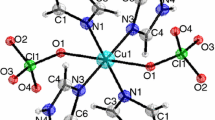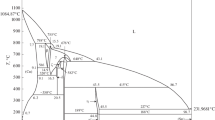Abstract
Experiments to determine the evaporation rates and aerosol formation mechanism of cadmium in molten copper at atmospheric pressure have been carried out. A small amount of cadmium (∼1 wt pct) was added to molten copper at 1473 K and allowed to evaporate while bubbling 750 and 1500 cm3/min of argon through the melt. Melt samples were periodically taken and analyzed by inductively coupled plasma/mass spectroscopy (ICP/MS) to determine their impurity content. A theoretical model to predict the evaporation rates of solutes from molten metals was developed and compared to the experimental results. Excellent correlation between experiment and theory was found for the cadmiumcopper system. The model has been extended to other solutes and also to molten Fe-3 (wt pct) C at 1873 K as a solvent.
Similar content being viewed by others
Abbreviations
- A b :
-
interfacial contact area between bubble and melt or area of bubble cm2
- A ms :
-
area of melt surface cm2
- D X−1 :
-
diffusivity of X in the melt cm2/s
- D X−g :
-
diffusivity of X in the gas phase (cm2/s)
- d b :
-
bubble diameter (cm)
- d orif :
-
diameter of orifice (cm)
- G :
-
volumetric gas flow rate (cm3/s)
- g :
-
acceleration due to gravity (981 cm/s2)
- ΔG 0 :
-
standard Gibbs free energy change (J/mol)
- ΔG 0 X(pct)→X(l) :
-
standard Gibbs energy for solution of X to 1 mass pct solution in melt (J/mol)
- ΔG 0 X(l)αX(g) :
-
standard Gibbs energy change for solute evaporation (J/mol)
- ΔG :
-
change of Gibbs free energy (J/mol)
- Gr:
-
Grashof number
- f x :
-
Henrian activity coefficient
- H :
-
height of the melt (cm)
- h :
-
vertical distance between the bubble and bottom of the melt (cm)
- K ol,b :
-
overall mass transfer coefficient to bubbles (cm/s)
- K e :
-
overall evaporation coefficient (cm/s)
- k e :
-
interface mass transfer coefficient (cm/s)
- k g :
-
gas phase mass transfer coefficient (cm/s)
- k g :
-
normalized gas phase mass transfer coefficient (cm/s)
- k l :
-
liquid phase mass transfer coefficient (cm/s)
- K ol,ms :
-
overall mass transfer coefficient for the melt surface (cm/s)
- M X :
-
mass of the solute (g)
- M l :
-
mass of the melt (g)
- MW X :
-
molecular weight of the solute (g/gmol)
- MW l :
-
molecular weight of the melt (g/mol)
- N X :
-
overall molar flux of solute X (mol/cm2s)
- N X(c) :
-
molar flux of solute X in the interface (mol/cm2s)
- N X(g) :
-
molar flux of solute X in gas phase (mol/cm2s)
- N X(l) :
-
molar flux of solute X in liquid phase (mol/cm2s)
- P :
-
pressure (atm or Pa)
- P 0 X :
-
vapor pressure of solute (atm of Pa)
- P X :
-
partial pressure of solute (atm or Pa)
- P eq :
-
equilibrium partial pressure of solute (atm or Pa)
- P exit X :
-
exit partial pressure of solute (atm or Pa)
- Pr:
-
Prandtl number
- Q :
-
molar gas flow rate (mol/s)
- R :
-
radius of bubble or universal gas constant (cm)(J/molK)
- Re:
-
Reynolds number
- Sh:
-
Sherwood number
- T :
-
temperature (K)
- t :
-
time (s)
- U b :
-
bubble rise velocity (cm/s)
- V b :
-
volume of bubble (cm3)
- γ X :
-
activity coefficient of solute X
- ϱ l :
-
desity of melt (g/cm3)
- ϱ X :
-
density of solute (g/cm3)
- ϱ g :
-
density of gas (g/cm3)
- σ l :
-
surface tension of melt (dyn/cm)
- σ X :
-
surface tension of solute (dyn/cm)
- μ g :
-
viscosity of solute (g/cm s)
- μ l :
-
viscosity of melt (g/cm s)
References
F. Feizollahi, W.J. Quapp, H.G. Hemphill, and S.J. Graffie: Report No. EGG-MS-11211, Contract No. DE-AC07-761D01570, Idaho National Engineering and Environmental Laboratory, Idaho Falls, ID, July 1994.
E. Ozberk and R.I.L. Guthrie: Mater. Sci. Technol., 1985, vol. 1, pp. 12–18.
R. Ohno: Metall. Trans. B, 1991, vol. 22B, pp. 447–65.
R.G. Ward and T.D. Aurini: J. Iron Steel Inst., 1996, Sept., pp. 920–23.
R. Ward: J. Iron Steel Inst., 1963, vol. 201, pp. 11–15.
K. Ito, M. Kishimoto, and K. Mori: Tetsu-to-Hagané, 1992, vol. 9, pp. 1441–48.
I. Barin and M. Modigell: Erzmetallurgy, 1986, vol. 39, pp. 618–23.
M. Hino, S. Wang, T. Nagasaka, and S. Ban-Ya: J. Iron Steel Inst., 1994, vol. 34, pp. 491–97.
T.A. Engh: Principles of Metal Refining, Oxford University Press, New York, NY, 1992, pp. 171–217 and 315–31.
A. Sarofim, M. Flemings, J. Tester, G. Senel, and J. Benavides: Application of Solution Thermodynamics and Aerosol Dynamics to Enhance Residue Segregation in Molten Metal Waste Processing, Idaho National Engineering and Environmental Laboratory, Idaho Falls, ID, July 1997.
R. Higbie: Trans. Inst. Chem. Eng., 1935, vol. 31, pp. 365–89.
P. Yim: Ph.D. Thesis, Massachusetts Intitute of Technology, Cambridge, MA, 1996.
C.V. Drysdale, A.H. Ferguson, A.E.M. Geddes, A.H. Gibson, F.R.W. Hunt, Sir H. Lamb, and Sir G.I. Taylor: The Mechanical Properties of Fluids; A Collective Work, 2nd ed., Blackie & Son, Ltd., 1946.
W.H. McAdams: Heat Transmission, 3rd ed., McGraw-Hill, New York, NY, 1954, p. 180.
A. Pelton and C. Bale: Metall. Trans. A, 1986, vol. 17A, pp. 1211–15.
G. Sigworth and J. Elliot: Can. Met. Q., 1974, vol. 13, p. 455.
W. Hayduk and B.S. Minhas: Can. J. Chem. Eng., 1982, vol. 60, p. 295.
M.T. Tyn and W.F. Calus: J. Chem. Data, 1975, vol. 20, p. 106.
M. Sano and K. Mori: Trans. JIM, 1976, vol. 17, p. 344.
K. Wraith and T. Kakutani: Chem. Eng. Sci., 1974, vol. 29, p. 1.
J. Grace: Trans. Inst. Chem. Eng., 1973, vol. 51, p. 116.
C.C. Maneri and H.D. Mendelson: AIChE J., 1968, vol. 14, p. 295.
W. McCabe, J. Smith, and P. Harriott: Unit Operations of Chemical Engineering, 4th ed., McGraw-Hill, New York, NY, 1985.
G. Geiger and D. Poirier: Transport Phenomena in Metallurgy, Addison-Wesley, New York, NY, 1973.
Author information
Authors and Affiliations
Rights and permissions
About this article
Cite this article
Benavides, J., Senel, G.I., Flemings, M.C. et al. The evaporation rates and mechanisms of cadmium from a bubble-stirred molten copper bath. Metall Mater Trans B 32, 285–295 (2001). https://doi.org/10.1007/s11663-001-0051-5
Received:
Issue Date:
DOI: https://doi.org/10.1007/s11663-001-0051-5




